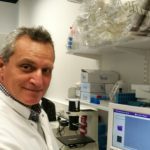Lien vers Pubmed [PMID] – 23581595
J. Neurosurg. 2013 Sep;119(3):739-50
OBJECT: Facial nerve injury results in facial palsy that has great impact on the psychosocial conditions of affected patients. Reconstruction of the facial nerve to restore facial symmetry and expression is still a significant surgical challenge. In this study, the authors assessed a hypoglossal-facial nerve anastomosis method combined with neurotrophic factor gene therapy to treat facial palsy in adult rats after facial nerve injury.
METHODS: Surgery consisted of the interposition of a predegenerated nerve graft (PNG) that was anastomosed with the hypoglossal and facial nerves at each of its extremities. The hypoglossal nerve was cut approximately 50% for this anastomosis to conserve partial hypoglossal function. Before their transplantation, the PNGs were genetically engineered using lentiviral vectors to induce overexpression of the neurotrophic factor neurotrophin-3 (NT-3) to improve axonal regrowth in the reconstructed nerve pathway. Reconstruction was performed after facial nerve injury, either immediately or after a delay of 9 weeks. The rats were followed up for 4 months postoperatively, and treatment outcomes were then assessed.
RESULTS: Compared with the functional innervation in control rats that underwent facial nerve injury without subsequent treatment, functional innervation of the paralyzed whisker pad by hypoglossal motoneurons in rats treated 4 months after nerve reconstruction was evidenced by the retrograde transport of neuronal tracers, the recording of muscle action potentials conducted by the PNG, and the recovery of facial symmetry. Although a better outcome was observed when reconstruction was performed immediately after facial nerve injury, reconstruction with NT3-treated PNGs significantly improved functional reinnervation of the paralyzed whisker pad even when implantation occurred 9 weeks posttrauma.
CONCLUSIONS: Results demonstrated that hypoglossal-facial nerve anastomosis facilitates innervation of paralyzed facial muscle via hypoglossal motoneurons without sacrificing ipsilateral hemitongue function. Neurotrophin-3 treatment through gene therapy could effectively improve such innervation, even after delayed reconstruction. These findings suggest that the combination of surgical reconstruction and NT-3 gene therapy is promising for its potential application in treating facial palsy in humans.

